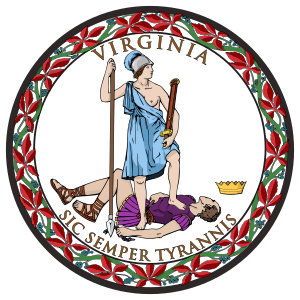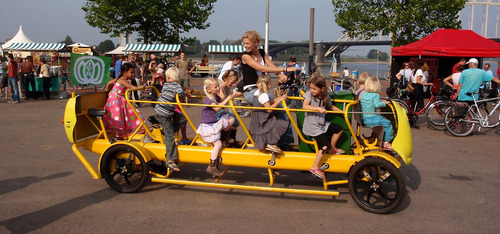
English: The state seal of Virginia. Српски / Srpski: Застава америчке савезне државе Вирџиније. (Photo credit: Wikipedia)
This is a guest post by Michael Rodriguez, a friend and business colleague, on one of the most pressing questions facing Virginia’s voters tomorrow in the 2012 elections. A quick bio of the author: Mike is a Transportation planning/economics consultant. Identifies himself as a Tech junkie. Apple enthusiast. Marlins fan. Badger fan. Nintendo fanboy. Overall transportation geek. Mike is also actively engaged in Twitter (@TranspoPlanner) and you can learn more about him here.
On Election Day, Virginians will encounter a statewide ballot measure,Question 1, that would amend the Virginia Constitution by limiting the government’s ability to exercise eminent domain – limitations that would hinder critical projects such as Metro Rail expansion, the new 495 Express Lanes, and many worthy economic development projects. The true implications of this amendment are an unnecessary restriction on public projects, a narrow definition of eminent domain powers leading to greater costs, and other negative unintended consequences.Virginia Question 1: Bad for Infrastructure and Bad for Communities
Eminent domain, the government’s power to acquire private property for public use, is central to state and local government’s ability to build infrastructure and facilities – things like roads, water lines, parks, schools, and police precincts. In 2005, the U.S. Supreme Court in Kelo v. City of New London also upheld a practice that local governments had been engaged in for quite some time, namely, acquiring land and transferring it to a private developer when undergoing economic redevelopment. However, the Court also left states with the power to restrict this practice.
Since Kelo, a concerted, partisan response in many states has sought to severely limit the government’s power to conduct its business through eminent domain and undermine urban and regional planning in general. Question 1 is Virginia’s version of this partisan effort. While framed as a “property rights” issue, make no mistake that this amendment goes too far and tries to slip in significant roadblocks to all public projects that use eminent domain.
Question 1 is unnecessary to prevent the type of eminent domain use in Kelo because Virginia has already enacted laws to address this. Despite these statutes, the proponents behind Question 1 seek to go beyond what is already on the books. In the process, they are willing to open up Pandora’s Box of problems that they have failed to address. These problems are why the Virginia Municipal League, Virginia Association of Counties, and mayors across Virginia strongly believe Question 1 is a setback for building needed infrastructure and the ability to create strong and vibrant communities.
One problem is that Question 1 would hinder innovative projects in transportation, among other areas, by limiting eminent domain in any setting that would be “for profit.” Immediately, this language would obstruct and likely stop any toll road, port redevelopment, or other project that uses “public-private partnerships” – where the government and private sector collaborate. These types of projects have traditionally had bi-partisan support in Virginia and nationwide, including support from Governor McDonnell. Nonetheless, Question 1 would prevent such projects.
What this means for Virginians is that projects like the 495 Express Lanes would be challenged, since these projects involve the government and private sector collaborating over toll revenues. Projects like Metro Rail’s Silver Line expansion to Dulles Airport would be thwarted, since they are partly financed through those tolls. In short, Question 1 unnecessarily interferes in government’s ability to collaborate with the private sector to innovate and improve our transportation and public facilities.
Another concern is that Question 1 also requires the government to compensate property owners not only for their property’s value, but also for “lost profits.” For example, farmers would not only be compensated for their land at market value, but also for profits they may (or may not) experience in the future from sales of their produce. While a noble goal,there is a fundamental math problem with this logic. The future profits of a piece of real estate, like a farm or factory, are already incorporated into its market value – economists call it “capitalized value.” This is why a high yielding farm sells for more than a low yielding farm, all other things being equal.
The existing norm of compensating at market value already addresses these potential profits; so requiring additional compensation is economic double counting. Furthermore, profits are speculative, and the overall effect is to limit public projects by increasing costs, encouraging frivolous litigation, enriching trial attorneys, and enabling an unelected board to guess at compensation levels. In the end, we all pay for this when the cost of building public infrastructure increases drastically.
There are a host of other unintended consequences, but the bottom line is that Question 1 goes beyond simply protecting private property rights. It would nearly kill, or at least severely inhibit, public-private partnerships to build infrastructure, thus requiring more government bonds and debt to build. It would also increase the cost that we Virginians pay for our roads and other infrastructure. Do not be fooled. A vote in favor of Question 1 might be a great deal for trial lawyers, but it’s a bad deal for Virginia’s infrastructure and the future of our communities.
Note: All opinion expressed are the author’s. This blog serves as a platform to echo the voices of the community. Feel free to share and register your thoughts below. Also, you are welcome to submit articles on transportation issues for publishing on this site.







































